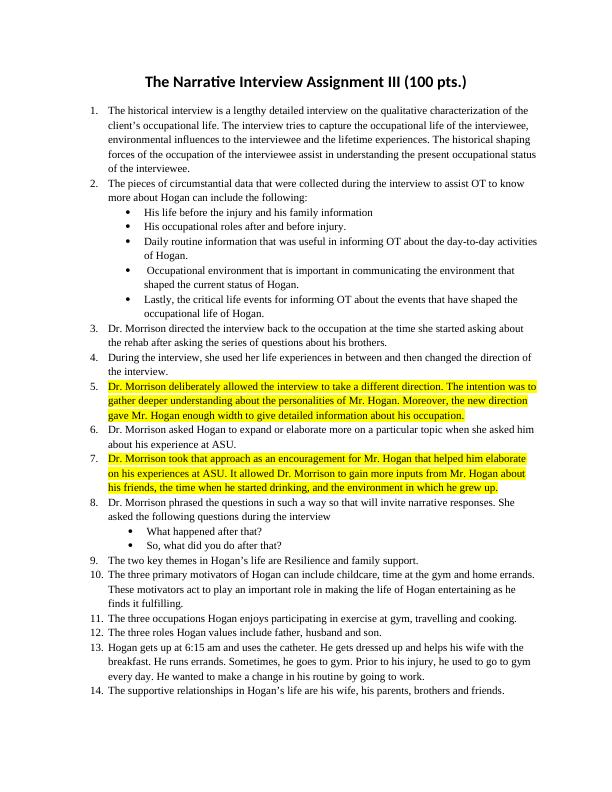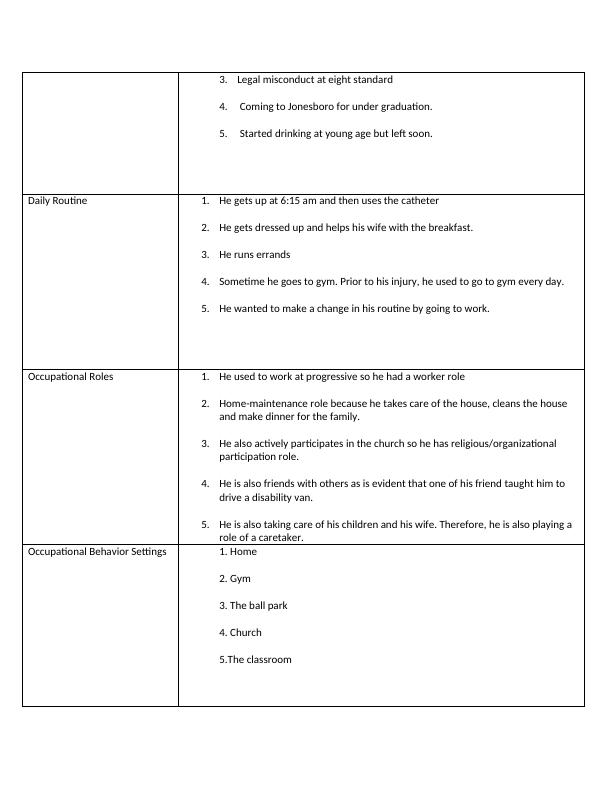The Narrative Interview Assignment
Added on 2019-09-30
7 Pages2861 Words168 Views
The Narrative Interview Assignment III (100 pts.)1.The historical interview is a lengthy detailed interview on the qualitative characterization of the client’s occupational life. The interview tries to capture the occupational life of the interviewee, environmental influences to the interviewee and the lifetime experiences. The historical shaping forces of the occupation of the interviewee assist in understanding the present occupational status of the interviewee.2.The pieces of circumstantial data that were collected during the interview to assist OT to know more about Hogan can include the following:His life before the injury and his family informationHis occupational roles after and before injury.Daily routine information that was useful in informing OT about the day-to-day activitiesof Hogan. Occupational environment that is important in communicating the environment that shaped the current status of Hogan. Lastly, the critical life events for informing OT about the events that have shaped the occupational life of Hogan.3.Dr. Morrison directed the interview back to the occupation at the time she started asking about the rehab after asking the series of questions about his brothers.4.During the interview, she used her life experiences in between and then changed the direction of the interview.5.Dr. Morrison deliberately allowed the interview to take a different direction. The intention was to gather deeper understanding about the personalities of Mr. Hogan. Moreover, the new direction gave Mr. Hogan enough width to give detailed information about his occupation.6.Dr. Morrison asked Hogan to expand or elaborate more on a particular topic when she asked him about his experience at ASU.7.Dr. Morrison took that approach as an encouragement for Mr. Hogan that helped him elaborate on his experiences at ASU. It allowed Dr. Morrison to gain more inputs from Mr. Hogan about his friends, the time when he started drinking, and the environment in which he grew up.8.Dr. Morrison phrased the questions in such a way so that will invite narrative responses. She asked the following questions during the interviewWhat happened after that? So, what did you do after that?9.The two key themes in Hogan’s life are Resilience and family support.10.The three primary motivators of Hogan can include childcare, time at the gym and home errands. These motivators act to play an important role in making the life of Hogan entertaining as he finds it fulfilling.11.The three occupations Hogan enjoys participating in exercise at gym, travelling and cooking.12.The three roles Hogan values include father, husband and son.13.Hogan gets up at 6:15 am and uses the catheter. He gets dressed up and helps his wife with the breakfast. He runs errands. Sometimes, he goes to gym. Prior to his injury, he used to go to gym every day. He wanted to make a change in his routine by going to work.14.The supportive relationships in Hogan’s life are his wife, his parents, brothers and friends.

15.Hogan explained the “turning” in his life when he was not able to feel anything at and below the injury level. When staff took his blood and he could not feel anything.16.He made this decision because his health was degrading and he was unable to sustain longer in such circumstances. His internal motivation helped him give a new direction to his life.17.Hogan expresses a desire to improve upon his work status. He used to work at progressive. Now he wants to work again. He also expresses the desire to go to the gym more often as he used to go.18.He feels a sense of mastery or control on his community mobility. He told about his experience when he learned driving after the injury and now he can go around with his family on trips. Hogan also feels a sense of mastery or control over his personal care such as bladder control. He also provided the example by telling the story about his experience at a ball game.19.An example of a metaphor developed during the interview is “Rage against the Machine”. It was used in explaining the aggressiveness of Hogan where he could do all what he could to achieve his life goals. The other metaphors are “Not stopping on anything attribute” and “Mind is your mind but your body is not same”20.Yes, Dr. Morrison used tools as spring board for the interview. Dr. Morrison asked Hogan about urination after his injury and used a catheter as a springboard to know more about his self-care routine.21.Yes, Dr. Morrison modeled narratives during the interview. She used this approach several timesduring the interview. She narrated her experience when she hit the sonic menu with her car. She did not want to let her parents know and she hid her car at her friend’s home. 22.Yes23.He didn’t explain about his mischievousness which he had done when he was young. 24.N/A25.Dr. Morrison used the box approach because box approach is not rigid and involves the alternating routes depending on the response of the client. Topical Areas (5 pts./area; 25 points total)Identify 5 pieces of supportive information for each area (1 pt. each)Occupational Choices1.For education purposes, he moved to Jonesboro2.Exercise at gym3.Cooking 4.Wanted to work5.Learned drivingCritical Life Events1.His injury during duck hunting2.Attended military academy due to his mischievous behavior

3.Legal misconduct at eight standard4. Coming to Jonesboro for under graduation.5. Started drinking at young age but left soon.Daily Routine1.He gets up at 6:15 am and then uses the catheter2.He gets dressed up and helps his wife with the breakfast.3.He runs errands4.Sometime he goes to gym. Prior to his injury, he used to go to gym every day.5.He wanted to make a change in his routine by going to work.Occupational Roles1.He used to work at progressive so he had a worker role 2.Home-maintenance role because he takes care of the house, cleans the house and make dinner for the family.3.He also actively participates in the church so he has religious/organizational participation role.4.He is also friends with others as is evident that one of his friend taught him to drive a disability van.5.He is also taking care of his children and his wife. Therefore, he is also playing a role of a caretaker. Occupational Behavior Settings1. Home2. Gym3. The ball park 4. Church5.The classroom

End of preview
Want to access all the pages? Upload your documents or become a member.
